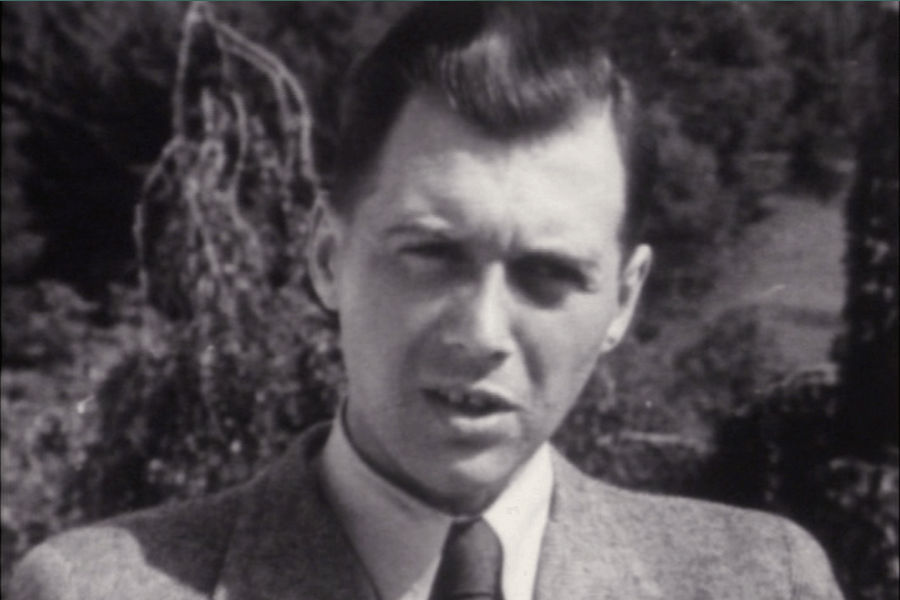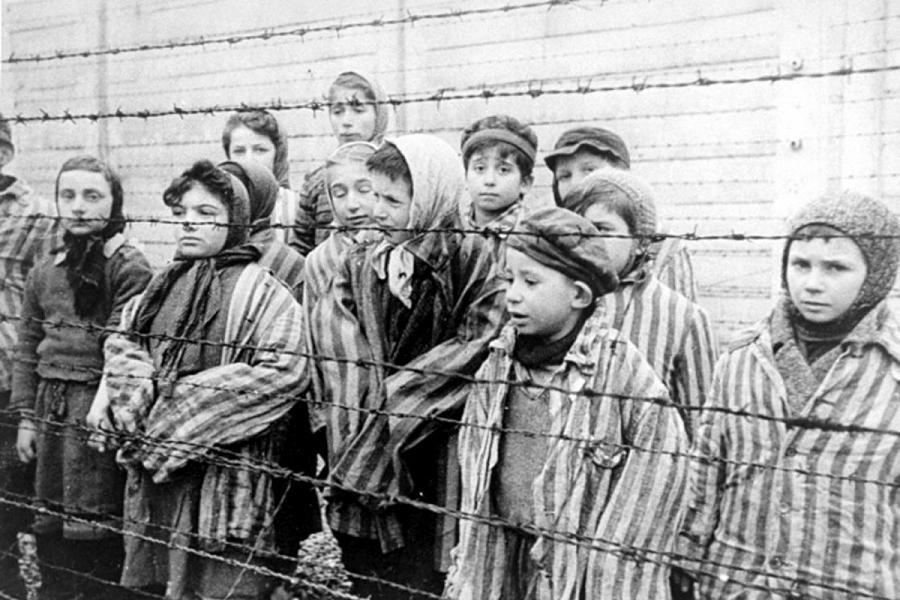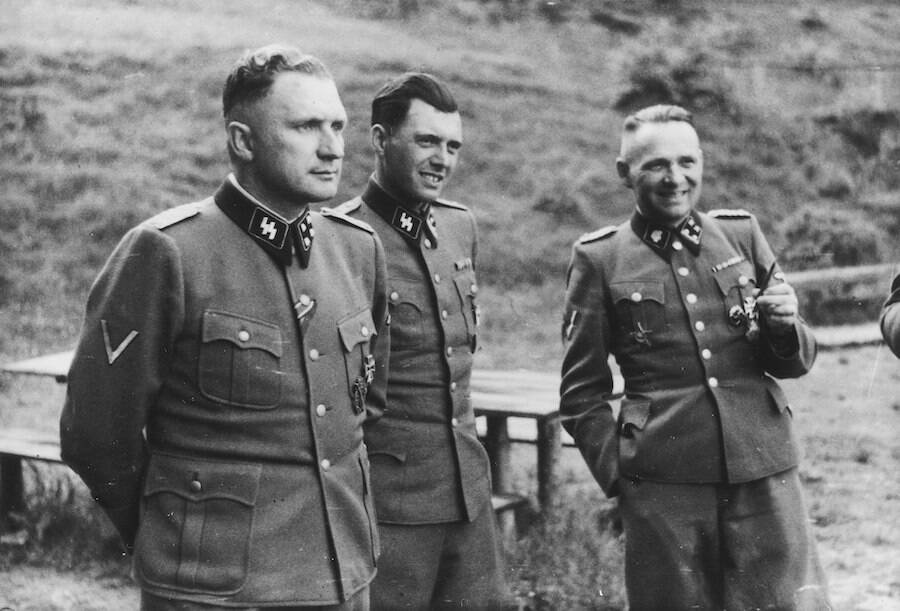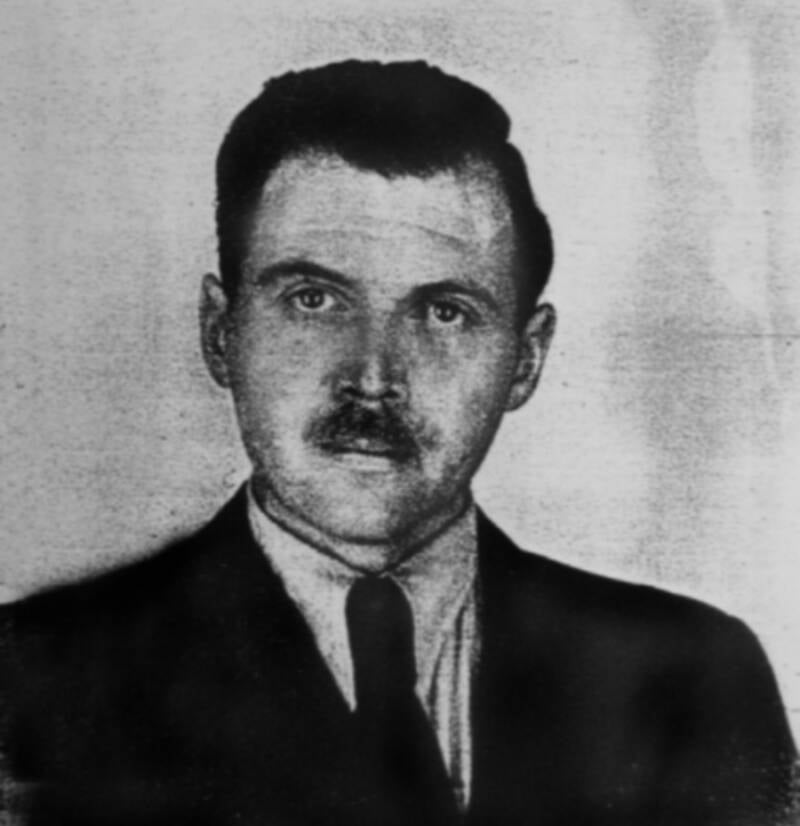A notorious SS officer and physician, Josef Mengele sent over 400,000 people to their deaths at Auschwitz during World War II — and never faced justice.
One of the most notorious Nazi doctors of World War II, Josef Mengele performed gruesome medical experiments on thousands of prisoners at the Auschwitz concentration camp. Guided by an unwavering belief in the unscientific Nazi racial theory, Mengele justified countless inhumane tests and procedures on Jewish and Romani people.
From 1943 to 1945, Mengele built up a reputation as the “Angel of Death” at Auschwitz. Like other Nazi doctors on-site, Mengele was tasked with choosing which prisoners would be murdered immediately and which ones would be kept alive for grueling labor — or for human experiments. But many prisoners remembered Mengele as being particularly cruel.
Not only was Mengele known for his cold demeanor on the arrival platform of Auschwitz — where he sent about 400,000 people to their deaths in the gas chambers — but he was also infamous for his brutality during his human experiments. He saw his victims as mere “test subjects,” and gleefully embarked on some of the most monstrous “research” of the war.
But as World War II came to a close and it became clearer that Nazi Germany was losing, Mengele fled the camp, was briefly captured by American soldiers, attempted to take up work as a farmhand in Bavaria, and eventually escaped to South America — never facing justice for his crimes.
On June 6, 1985, Brazilian police in São Paulo dug up the grave of a man named “Wolfgang Gerhard.” Forensic and later genetic evidence conclusively proved that the remains actually belonged to Josef Mengele, who had apparently died in a swimming accident in Brazil a few years prior.
This is the horrific true story of Josef Mengele, the Nazi doctor who terrorized thousands of Holocaust victims — and got away with everything.
Inside Josef Mengele’s Privileged Youth

Wikimedia CommonsJosef Mengele came from a wealthy family and appeared to have been destined for success at an early age.
Josef Mengele lacks a terrible backstory to which one can point a finger when attempting to explain his vile acts. Born on March 16, 1911, in Günzburg, Germany, Mengele was a popular and rich child whose father ran a successful business at a time when the national economy was cratering.
Everybody at school seemed to like Mengele and he earned excellent grades. Upon graduating, it seemed natural that he would go on to university and that he would succeed at anything he put his mind to.
Mengele earned his first doctorate in anthropology from the University of Munich in 1935. According to the New York Times, he did his post-doctoral work at the Frankfurt Institute for Hereditary Biology and Racial Hygiene under Dr. Otmar Freiherr von Verschuer, who was a Nazi eugenicist.
The ideology of National Socialism had always held that individuals were the product of their heredity, and von Verschuer was one of the Nazi-aligned scientists whose work attempted to legitimize that assertion.
Von Verschuer’s work revolved around hereditary influences on congenital defects such as cleft palates. Mengele was an enthusiastic assistant to von Verschuer, and he left the lab in 1938 with both a glowing recommendation and a second doctorate in medicine. For his dissertation topic, Mengele wrote about racial influences on the formation of the lower jaw.
But before long, Josef Mengele would be doing far more than simply writing about topics like eugenics and Nazi racial theory.
Josef Mengele’s Early Work With The Nazi Party

Wikimedia CommonsBefore he worked on horrific experiments at Auschwitz, Josef Mengele thrived as an SS medical officer.
According to the United States Holocaust Memorial Museum, Josef Mengele had joined the Nazi Party in 1937, at the age of 26, while working under his mentor in Frankfurt. In 1938, he joined the SS and a reserve unit of the Wehrmacht. His unit was called up in 1940, and he seems to have served willingly, even volunteering for the Waffen-SS medical service.
Between the fall of France and the invasion of the Soviet Union, Mengele practiced eugenics in Poland by evaluating Polish nationals for potential “Germanization,” or race-based citizenship in the Third Reich.
In 1941, his unit was deployed to Ukraine in a combat role. There, Josef Mengele quickly distinguished himself on the Eastern Front. He was decorated several times, once for dragging wounded men out of a burning tank, and was repeatedly commended for his dedication to service.
But then, in January 1943, a German army surrendered at Stalingrad. And that summer, another German army was eviscerated at Kursk. Between the two battles, during the meatgrinder offensive at Rostov, Mengele was severely wounded and rendered unfit for further action in a combat role.
Mengele was shipped back home to Germany, where he connected with his old mentor von Verschuer and received a wound badge, a promotion to captain, and the assignment that would make him infamous: In May 1943, Mengele reported for duty to the concentration camp at Auschwitz.
The “Angel Of Death” At Auschwitz

United States Holocaust Memorial Museum/Yad VashemAuschwitz was the largest Nazi concentration camp of World War II. Over 1 million people died there.
Mengele got to Auschwitz during a transitional period. The camp had long been the site of forced labor and POW internment, but the winter of 1942-1943 had seen the camp ramp up its killing machine, centered on the Birkenau sub-camp, where Mengele was assigned as a medical officer.
With the uprisings and shutdowns in the Treblinka and Sobibor camps, and with the increased tempo of the killing program across the East, Auschwitz was about to get very busy, and Mengele was going to be in the thick of it.
Accounts given later by both survivors and guards describe Josef Mengele as an enthusiastic member of the staff who volunteered for extra duties, managed operations that were technically above his pay grade, and seemed to be almost everywhere at the camp at once. There’s no question that Mengele was in his element in Auschwitz. His uniform was always pressed and neat, and he always seemed to have a faint smile on his face.
Every doctor in his part of the camp was required to take a turn as the selection officer — dividing incoming shipments of prisoners between those who were to work and those who were to be immediately gassed — and many found the work depressing. But Josef Mengele adored this task, and he was always willing to take other doctors’ shifts on the arrival ramp.
Other than determining who would be gassed, Mengele also managed an infirmary where the sick were executed, assisted other German doctors with their tasks, supervised inmate medical staff, and conducted his own research among the thousands of inmates whom he had personally selected for the human experiment program that he also started and managed.

Wikimedia Commons Josef Mengele often targeted twins for his brutal medical experiments at Auschwitz.
The experiments Josef Mengele devised were ghoulish beyond belief. Motivated and energized by the seemingly bottomless pool of condemned human beings placed at his disposal, Mengele continued the work he had started at Frankfurt by studying the influence of heredity on various physical traits. According to the History Channel, he used thousands of prisoners — many of whom were still children — as fodder for his human experiments.
He favored identical twin children for his genetics research because they, of course, had identical genes. Any differences between them, therefore, must have been the result of environmental factors. In Mengele’s eyes, this made sets of twins the perfect “test subjects” for isolating genetic factors by comparing and contrasting their bodies and their behavior.
Mengele assembled hundreds of pairs of twins and sometimes spent hours measuring various parts of their bodies and taking careful notes on them. He often injected one twin with mysterious substances and monitored the illness that ensued. Mengele also applied painful clamps to children’s limbs to induce gangrene, injected dye into their eyes — which were then shipped back to a pathology lab in Germany — and gave them spinal taps.
Whenever a test subject died, the child’s twin would be immediately killed with an injection of chloroform to the heart and both would be dissected for comparison. On one occasion, Josef Mengele killed 14 pairs of twins this way and spent a sleepless night performing autopsies on his victims.
Josef Mengele’s Volatile Temperament

Wikimedia Commons Josef Mengele (center) with fellow SS officers Richard Baer and Rudolf Höss outside of Auschwitz in 1944.
For all of his methodical work habits, Mengele could be impulsive. During one selection — between work and death — on the arrival platform, a middle-aged woman who had been selected for work refused to be separated from her 14-year-old daughter, who had been assigned death.
A guard who tried to pry them apart got a nasty scratch on the face and had to fall back. Mengele stepped in to resolve the matter by shooting both the girl and her mother right on the spot. After murdering them, he then cut short the selection process and sent everybody to the gas chamber.
On another occasion, the Birkenau doctors argued over whether a boy they had all grown fond of had tuberculosis. Mengele left the room and came back an hour or two later, apologizing for the argument and admitting that he had been wrong. During his absence, he had shot the boy and then dissected him for signs of the disease, which he hadn’t found.
In 1944, Mengele’s zest and enthusiasm for his gruesome work earned him a management position at the camp. In this capacity, he was responsible for public health measures at the camp in addition to his own personal research at Birkenau. Again, his impulsive streak surfaced when he made decisions for the tens of thousands of vulnerable inmates.
When typhus broke out among the women’s barracks, for example, Mengele solved the problem in his characteristic way: He ordered one block of 600 women gassed and their barracks fumigated, then he moved the next block of women over and fumigated their barracks. This was repeated for each women’s block until the last one was clean and ready for a new shipment of workers. He did it again a few months later during a scarlet fever outbreak.

Yad Vashem/Twitter Josef Mengele, pictured while conducting one of many horrific human experiments.
And through it all, Josef Mengele’s experiments continued, becoming more and more barbaric as time went on. Mengele stitched pairs of twins together at the back, gouged out the eyes of people with different-colored irises, and vivisected children who once knew him as the kindly old “Uncle Papi.”
When a form of gangrene called noma broke out in a Romani camp, Mengele’s absurd focus on race led him to investigate the genetic causes he was sure were behind the epidemic. To study this, he sawed off the heads of infected prisoners and sent the preserved samples to Germany for study.
After most of the Hungarian prisoners were killed off during the summer of 1944, the transports of new prisoners to Auschwitz slowed down during the autumn and the winter and eventually stopped altogether.
By January 1945, the camp complex at Auschwitz had been mostly dismantled and the starving prisoners force-marched to — of all places — Dresden (which was about to be bombed by the Allies). Josef Mengele packed up his research notes and specimens, dropped them off with a trusted friend, and headed west to avoid capture by the Soviets.
A Shocking Escape And An Evasion Of Justice

Wikimedia CommonsA photo taken from Josef Mengele’s Argentine identification documents. Circa 1956.
Josef Mengele managed to avoid the victorious Allies until June — when he was picked up by an American patrol. He was traveling under his own name at the time, but the wanted criminal list hadn’t been efficiently distributed and so the Americans let him go. Mengele spent some time working as a farmhand in Bavaria before deciding to escape Germany in 1949.
Using a variety of aliases, and sometimes his own name again, Mengele managed to avoid capture for decades. It helps that almost nobody was looking for him and that the governments of Brazil, Argentina, and Paraguay were all highly sympathetic to the escaping Nazis who sought refuge there.
Even in exile, and with the world to lose if he got caught, Mengele just couldn’t lay low. In the 1950s, he opened an unlicensed medical practice in Buenos Aires, where he specialized in performing illegal abortions.
This actually got him arrested when one of his patients died, but according to one witness, a friend of his showed up in court with a bulging envelope full of cash for the judge, who subsequently dismissed the case.

Bettmann/GettyJosef Mengele (center, at edge of table), pictured with friends in the 1970s.
Israeli efforts to capture him were diverted, first by the chance to capture SS lieutenant colonel Adolf Eichmann, then by the looming threat of war with Egypt, which drew the Mossad’s attention away from fugitive Nazis.
Finally, on February 7, 1979, the 67-year-old Josef Mengele went out for a swim in the Atlantic Ocean, near São Paulo, Brazil. He suffered a sudden stroke in the water and drowned. After Mengele’s death, his friends and family members gradually admitted that they had known all along where he had been hiding and that they had sheltered him from facing justice.
In March 2016, a Brazilian court awarded control over Mengele’s exhumed remains to the University of São Paulo. It was then decided that his remains would be used by student doctors for medical research.
After learning about Josef Mengele and his terrifying human experiments, read about Ilse Koch, the notorious “Bitch of Buchenwald.” Then, meet the men who helped Adolf Hitler rise to power.





